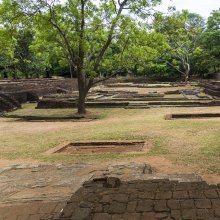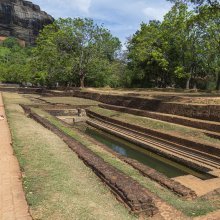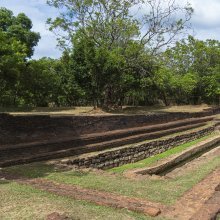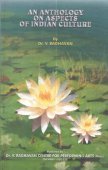Water: 7 definitions
Introduction:
Water means something in Hinduism, Sanskrit, Jainism, Prakrit, Hindi. If you want to know the exact meaning, history, etymology or English translation of this term then check out the descriptions on this page. Add your comment or reference to a book if you want to contribute to this summary article.
Images (photo gallery)
(+93 more images available)
In Hinduism
Ayurveda (science of life)
Veterinary Medicine (The study and treatment of Animals)
Source: Asian Agri-History: Paśu Āyurvēda (Veterinary Medicine) in GaruḍapurāṇaWater (in Sanskrit: toya) is used in the various Anupāna (“drink take”), according to sections on the treatment of Horses (Gajāyurveda or Aśvāyurveda) in the Garuḍapurāṇa.—The Anupāna i.e. the drink take along with or after medicine was important in treatment. Because it may help in carrying, absorption, assimilation and enhancing action of the drugs. Normally the selection of anupāna is done depends upon disease, doṣa etc.—[...] In diseases of the deranged and aggravated vāyu the medicine should be administered through the taila (oil), or in combination with śarkarā (sugar), ājya/ghṛita (ghee) or toya (water).

Āyurveda (आयुर्वेद, ayurveda) is a branch of Indian science dealing with medicine, herbalism, taxology, anatomy, surgery, alchemy and related topics. Traditional practice of Āyurveda in ancient India dates back to at least the first millenium BC. Literature is commonly written in Sanskrit using various poetic metres.
Yoga (school of philosophy)
Source: ORA: Amanaska (king of all yogas): A Critical Edition and Annotated Translation by Jason BirchWater refers to one of the “five elemental powers” and represents one of the various signs and paranormal powers (siddhi) experienced by the Yoga practicioner, according to the Amanaska Yoga treatise (presented in the form of a dialogue between Īśvara and Vāmadeva).—The last fifty-two verses of the Amanaska’s first chapter describe a temporal sequence of psychosomatic signs and paranormal powers (siddhi) brought about by absorption (laya). In the Amanaska, The five elemental powers are, [e.g., water (toya-tattva )], [...].

Yoga is originally considered a branch of Hindu philosophy (astika), but both ancient and modern Yoga combine the physical, mental and spiritual. Yoga teaches various physical techniques also known as āsanas (postures), used for various purposes (eg., meditation, contemplation, relaxation).
Natyashastra (theatrics and dramaturgy)
Source: Shodhganga: Elements of Art and Architecture in the Trtiyakhanda of the Visnudharmottarapurana (natya)The Water colour (in Indian Dramas) is reserved for Vāsuki, as conveyed through the Aṅgaracanā division of Āhāryābhinaya: one of the four divisions of Abhinaya or “ways to convey or represent one’s emotion to others”, according to the Viṣṇudharmottarapurāṇa, an ancient Sanskrit text which (being encyclopedic in nature) deals with a variety of cultural topics such as arts, architecture, music, grammar and astronomy.—Aṅgaracanā meaning painting of limbs of different characters, also falls under the category of makeover. The Viṣṇudharmottarapurāṇa speaks that it should be done according to the caste, position, superiority and country of respective characters. As for example, this book suggests that Demons, Kuvera and Piṣācas should have the colour of water; [...] etc. The Nāṭyaśāstra also agrees on it. This is important to note that this type of notes and rules give a social implication of the performance.

Natyashastra (नाट्यशास्त्र, nāṭyaśāstra) refers to both the ancient Indian tradition (shastra) of performing arts, (natya—theatrics, drama, dance, music), as well as the name of a Sanskrit work dealing with these subjects. It also teaches the rules for composing Dramatic plays (nataka), construction and performance of Theater, and Poetic works (kavya).
Vastushastra (architecture)
Source: Shodhganga: Elements of Art and Architecture in the Trtiyakhanda of the Visnudharmottarapurana (vastu)Water (and moss) was traditionally mixed with Clay after having dried it on auspicious ground, in the process of creating Bricks which is an important Material used for the Construction of Walls and Temples, according to the Viṣṇudharmottarapurāṇa, an ancient Sanskrit text which (being encyclopedic in nature) deals with a variety of cultural topics such as arts, architecture, music, grammar and astronomy.—The Viṣṇudharmottarapurāṇa explains that in the brick making process in the first stage all the clay should be dried up in an auspicious ground and thereafter it should be gently mixed with water and moss. After that the dough of the clay should be shaped in a machine which should be one hand in length, half a hand in breadth and one forth hand in height. In that machine the clay should be baked in the fire of wood, cow-dung and grass and thus bricks got prepared. These bricks should be made in proper shape and be arranged skillfully in proper place.

Vastushastra (वास्तुशास्त्र, vāstuśāstra) refers to the ancient Indian science (shastra) of architecture (vastu), dealing with topics such architecture, sculpture, town-building, fort building and various other constructions. Vastu also deals with the philosophy of the architectural relation with the cosmic universe.
Shilpashastra (iconography)
Source: Shodhganga: Elements of Art and Architecture in the Trtiyakhanda of the Visnudharmottarapurana (shilpa)Water in a painting follow specific guidelines in the ancient Indian tradition of Painting (citra), according to the Viṣṇudharmottarapurāṇa, an ancient Sanskrit text which (being encyclopedic in nature) deals with a variety of cultural topics such as arts, architecture, music, grammar and astronomy.—According to the Viṣṇudharmottarapurāṇa, a picture having water or so to say showing water sources should be drawn with numerous fishes, tortoises and aquatic animals. Moreover, the picture of the autumn season should include the water-ponds along with lots of swans and lotuses. [...] Thus, the Viṣṇudharmottarapurāṇa addresses various elements of nature, such as water sources, since painting has much connection with time, mood and activity.

Shilpashastra (शिल्पशास्त्र, śilpaśāstra) represents the ancient Indian science (shastra) of creative arts (shilpa) such as sculpture, iconography and painting. Closely related to Vastushastra (architecture), they often share the same literature.
In Jainism
General definition (in Jainism)
Source: archive.org: TrisastisalakapurusacaritraWater is suitable for ascetics only if purified by some means, according to chapter 1.1 [ādīśvara-caritra] of Hemacandra’s 11th century Triṣaṣṭiśalākāpuruṣacaritra: an ancient Sanskrit epic poem narrating the history and legends of sixty-three illustrious persons in Jainism. Accordingly, “[...] The Ācārya [Dharmaghoṣa] said [to Dhana], ‘Food, etc., which has not been made nor caused to be made, nor intended (for them) is suitable for ascetics. Water too that has come from tanks, wells, ponds, etc., is prohibited unless it is purified by some means, according to the teaching of the Jinas, O caravan-chief’.”

Jainism is an Indian religion of Dharma whose doctrine revolves around harmlessness (ahimsa) towards every living being. The two major branches (Digambara and Svetambara) of Jainism stimulate self-control (or, shramana, ‘self-reliance’) and spiritual development through a path of peace for the soul to progess to the ultimate goal.
Languages of India and abroad
Hindi dictionary
Source: DDSA: A practical Hindi-English dictionaryWater in Hindi refers in English to:—(nm); -[kalara] watercolour; -[pemntimga] water painting; ~[prupha] water-proof; -[marka] watermark; ~[mena] the watermain; ~[varksa] waterworks..—water (वाटर) is alternatively transliterated as Vāṭara.
...
See also (Relevant definitions)
Starts with (+91): Water alisma, Water amaranth, Water apple, Water arum, Water beech, Water beggarticks, Water berry, Water birch, Water bouts, Water bush, Water buttercup, Water cacao, Water caltrops, Water canna, Water celery, Water chestnut, Water coconut, Water convolvulus, Water couch, Water couch grass.
Ends with: Barley-water, Chaff-water, Coconut water, Fish water, Flesh water, Hot water, Pure water, Rice-water, Saline water, Salt water, Scented water, Sesame-water, Sweet water, Walking on water, Water Element.
Full-text (+12906): Varuna, Jala, Toya, Acamana, Abhisheka, Jalayantra, Kalasha, Ambu, Udaka, Salila, Kamandalu, Paniya, Ap, Ambhas, Kumuda, Arghya, Padodaka, Payas, Vapi, Alinjara.
Relevant text
Search found 483 books and stories containing Water; (plurals include: Waters). You can also click to the full overview containing English textual excerpts. Below are direct links for the most relevant articles:
Charaka Samhita (English translation) (by Shree Gulabkunverba Ayurvedic Society)
Chapter 27h - The section on Waters (Jala) < [Sutrasthana (Sutra Sthana) — General Principles]
Chapter 22 - The therapeutics of Dipsosis (morbid thirst) (trishna-cikitsa) < [Cikitsasthana (Cikitsa Sthana) — Section on Therapeutics]
Chapter 27 - Diet and Dietetics (Annapana-vidhi) < [Sutrasthana (Sutra Sthana) — General Principles]
Satapatha-brahmana (by Julius Eggeling)
Kāṇḍa V, adhyāya 3, brāhmaṇa 4 < [Fifth Kāṇḍa]
Kāṇḍa VI, adhyāya 8, brāhmaṇa 2 < [Sixth Kāṇḍa]
Kāṇḍa III, adhyāya 9, brāhmaṇa 2 < [Third Kāṇḍa]
Chandogya Upanishad (Madhva commentary) (by Srisa Chandra Vasu)
Second Adhyaya, Fourth Khanda (2 mantras)
Third Adhyaya, Fourteenth Khanda (4 mantras)
Rivers in Ancient India (study) (by Archana Sarma)
1. The rivers in the Āraṇyakas < [Chapter 4 - The Rivers in the Āraṇyaka and Upaniṣadic Literature]
1. Samudra (ocean) in the Brāhmaṇas < [Chapter 3 - The Rivers in the Brāhmaṇa Literature]
5b. Greatness of Gaṅgā < [Chapter 5 - Rivers in the Purāṇic Literature]
The Agni Purana (by N. Gangadharan)
Chapter 64 - Mode of consecration of tanks and ponds (kūpa-pratiṣṭhā)
Chapter 155 - The code of conduct (ācāra)
Chapter 22 - Procedure for bathing prior to a religious rite
The Gautami Mahatmya (by G. P. Bhatt)
Related products
(+759 more products available)











